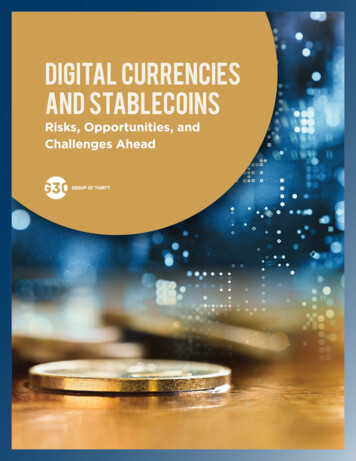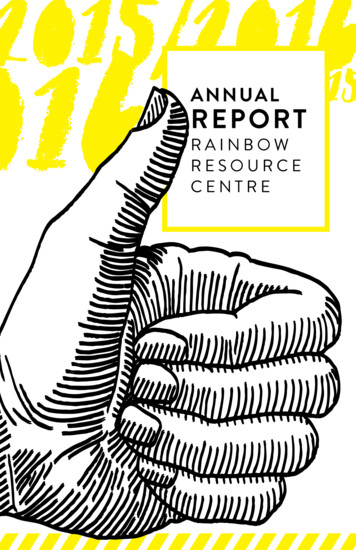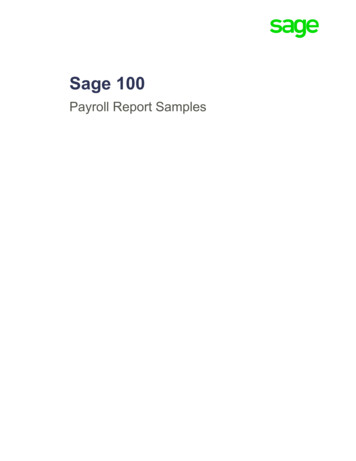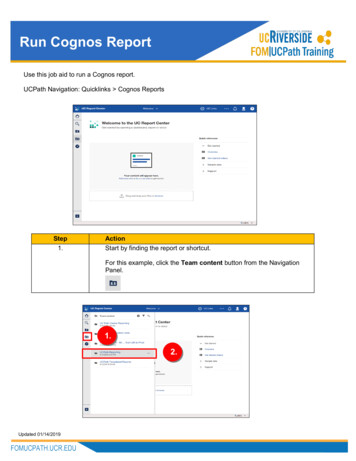
Transcription
CONTENTSExecutive Summary. 1I.Background . 4Creation and Redemption of the Stablecoin. 4Transfer and Storage of the Stablecoin. 5Activities and Participants in Stablecoin Arrangements . 6Use of Stablecoins. 7Digital Asset Trading Platforms and DeFi. 8II. Risks and Regulatory Gaps . 12Loss of Value: Risks to Stablecoin Users and Stablecoin Runs. 12Payment System Risks . 12Risks of Scale: Systemic Risk and Concentration of Economic Power. 14Regulatory Gaps. 14III. Recommendations. 15Legislation. 16Interim Measures. 18Illicit Finance Risk. 19International Standards. 22Annex: List of Outreach Participants. 23
INTERAGENCY REPORT ON STABLECOINSExecutive SummaryStablecoins are digital assets that are designed to maintain a stable value relative to a nationalcurrency or other reference assets. Today, stablecoins are primarily used in the United States tofacilitate trading, lending, or borrowing of other digital assets, predominantly on or through digitalasset trading platforms. Proponents believe stablecoins could become widely used by householdsand businesses as a means of payment. If well-designed and appropriately regulated, stablecoinscould support faster, more efficient, and more inclusive payments options. Moreover, the transitionto broader use of stablecoins as a means of payment could occur rapidly due to network effects orrelationships between stablecoins and existing user bases or platforms.Stablecoins and stablecoin-related activities present a variety of risks. Speculative digital assettrading,1 which may involve the use of stablecoins to move easily between digital asset platforms orin decentralized finance (DeFi) arrangements, presents risks related to market integrity and investorprotection. These market integrity and investor protection risks encompass possible fraud andmisconduct in digital asset trading, including market manipulation, insider trading, and front running,as well as a lack of trading or price transparency. Where these activities involve complex relationshipsor significant amounts of leverage, there may also be risks to the broader financial system. In addition,digital asset trading platforms and other market participants play a key role in providing access tostablecoins and liquidity in the market for stablecoins. To the extent activity related to digital assetsfalls under the jurisdiction of the Securities and Exchange Commission (SEC) and Commodity FuturesTrading Commission (CFTC), the SEC and CFTC have broad enforcement, rulemaking, and oversightauthorities that may address certain of these concerns (for more detail, see Digital Asset TradingPlatforms and DeFi).Stablecoins also pose illicit finance concerns and risks to financial integrity, including concerns relatedto compliance with rules governing anti-money laundering (AML) and countering the financing ofterrorism (CFT) and proliferation. To prevent misuse of stablecoins and other digital assets by illicitactors, Treasury will continue leading efforts at the Financial Action Task Force (FATF) to encouragecountries to implement international AML/CFT standards and pursue additional resources to supportsupervision of domestic AML/CFT regulations. Illicit finance concerns, and recommendations tomitigate illicit finance risks, are discussed in more detail in Illicit Finance Risk.In addition to market integrity, investor protection, and illicit finance concerns, the potential for theincreased use of stablecoins as a means of payment raises a range of prudential concerns. If stablecoinissuers do not honor a request to redeem a stablecoin, or if users lose confidence in a stablecoinissuer’s ability to honor such a request, runs on the arrangement could occur that may result inharm to users and the broader financial system. Further, to the extent stablecoins are widely used tofacilitate payments, disruptions to the payment chain that allows stablecoins to be transferred amongusers could lead to a loss of payments efficiency and safety and undermine the functioning of the1In general, references in this document to “digital asset trading” include trading, lending, or borrowing transactions that involve digital assets.1
broader economy. The potential for stablecoin arrangements to scale rapidly raises additional issuesrelated to systemic risk and concentration of economic power.There are key gaps in prudential authority over stablecoins used for payments purposes. This reportfocuses on analyzing prudential risks posed by stablecoins used as a means of payment and providesrecommendations for addressing these gaps.2 These prudential recommendations apply to “paymentstablecoins,” defined as those stablecoins that are designed to maintain a stable value relative toa fiat currency and, therefore, have the potential to be used as a widespread means of payment.These stablecoins are often, although not always, characterized by a promise or expectation that thestablecoin can be redeemed on a one-to-one basis for fiat currency.To address the prudential risks of payment stablecoins, the President’s Working Group on FinancialMarkets (PWG),3 along with the Federal Deposit Insurance Corporation (FDIC) and the Office of theComptroller of the Currency (OCC) (together, the agencies) recommend that Congress act promptlyto enact legislation to ensure that payment stablecoins and payment stablecoin arrangementsare subject to a federal prudential framework on a consistent and comprehensive basis. Becausepayment stablecoins are an emerging and rapidly developing type of financial instrument, legislationshould provide regulators flexibility to respond to future developments and adequately address risksacross a variety of organizational structures. Such legislation would complement existing authoritieswith respect to market integrity, investor protection and illicit finance, and would address keyprudential concerns: To address risks to stablecoin users and guard against stablecoin runs, legislation shouldrequire stablecoin issuers to be insured depository institutions, which are subject to appropriatesupervision and regulation, at the depository institution and the holding company level. To address concerns about payment system risk, in addition to the requirements for stablecoinissuers, legislation should require custodial wallet providers4 to be subject to appropriate federaloversight. Congress should also provide the federal supervisor of a stablecoin issuer with theauthority to require any entity that performs activities that are critical to the functioning of thestablecoin arrangement to meet appropriate risk-management standards.2Stablecoins are being used for trading, lending, borrowing, and, in the future, may also be widely used by households and businesses as ameans of payment. This report does not provide recommendations regarding issues or risks under the federal securities laws or the CommodityExchange Act (CEA) as they pertain to any digital assets, digital asset trading platforms, DeFi, stablecoins or stablecoin arrangements, and theprudential framework recommendations are not intended to affect any analysis under the federal securities laws or the CEA.3Executive Order 12631 of March 18, 1988 (Working Group on Financial Markets) established the President’s Working Group on FinancialMarkets, which is chaired by the Secretary of the Treasury, or their designee, and includes the Chair of the Board of Governors of theFederal Reserve System, the Chair of the Securities and Exchange Commission, and the Chair of the Commodity Futures TradingCommission, or their designees. The OCC and the FDIC also joined in this report.4Digital “wallets” provide a variety of services to users, including facilitating the transfer of stablecoins between users. A “custodial walletprovider” is a wallet provider that users may rely on to hold stablecoins on their behalf.2
To address additional concerns about systemic risk and concentration of economic power,legislation should require stablecoin issuers to comply with activities restrictions that limitaffiliation with commercial entities. Supervisors should have authority to implement standardsto promote interoperability among stablecoins. In addition, Congress may wish to consider otherstandards for custodial wallet providers, such as limits on affiliation with commercial entities or onuse of users’ transaction data.In the immediate term, the agencies are committed to taking action to address risks falling withineach agency’s jurisdiction, including efforts to ensure that stablecoins and related activity comply withexisting legal obligations, as well as continued coordination and collaboration on issues of commoninterest.In addition, in the absence of Congressional action, which is urgently needed to address the prudentialrisks inherent in payment stablecoins, the agencies recommend that the Financial Stability OversightCouncil (Council) consider steps available to it to address the risks outlined in this report. Such stepsmay include designation of certain activities conducted within a stablecoin arrangement as, or as likelyto become, systemically important payment, clearing, and settlement activities.The rapid growth of stablecoins increases the urgency of this work. Failure to act risks growth ofpayment stablecoins without adequate protection for users, the financial system, and the broadereconomy. In contrast, a regulatory framework that supports confidence in payment stablecoins,in normal times and in periods of stress, could increase the likelihood of stablecoins supportingbeneficial payments options. The recommendations in this report build on the work of internationalforums, including the Financial Stability Board, on stablecoin arrangements. See InternationalStandards for more detail.While the scope of this report is limited to stablecoins, work on digital assets and other innovationsrelated to cryptographic and distributed ledger technology is ongoing throughout the Administration.The Administration and the financial regulatory agencies will continue to collaborate closely on waysto foster responsible financial innovation, promote consistent regulatory approaches, and identify andaddress potential risks that arise from such innovation.The remainder of this report is organized as follows: Part I provides background on stablecoins,focusing on the mechanisms that support the creation and redemption of stablecoins, the transferand storage of stablecoins, and the activities and participants necessary to support a stablecoinarrangement; Part II of the report describes key prudential risks, and prudential regulatory gaps,attendant to the use of stablecoins as a means of payment; and Part III describes the agencies’recommendations for addressing prudential risks.3
I. BackgroundCreation and Redemption of the StablecoinStablecoins are generally created, or “minted,” in exchange for fiat currency that an issuer receivesfrom a user or third-party. To maintain a stable value relative to fiat currency, many stablecoins offera promise or expectation that the coin can be redeemed at par upon request. These stablecoins areoften advertised as being supported or backed by a variety of “reserve assets.” 5 However, there are nostandards regarding the composition of stablecoin reserve assets, and the information made publiclyavailable regarding the issuer’s reserve assets is not consistent across stablecoin arrangements as toeither its content or the frequency of its release. Based on information available, stablecoins differ inthe riskiness of their reserve assets, with some stablecoin arrangements reportedly holding virtuallyall reserve assets in deposits at insured depository institutions6 or in U.S. Treasury bills, and othersreportedly holding riskier reserve assets, including commercial paper, corporate and municipal bonds,and other digital assets.Stablecoin redemption rights can also vary considerably, in terms of both who may present astablecoin to an issuer for redemption and whether there are any limits on the quantity of coins thatmay be redeemed.7 Some issuers are permitted under the terms of the arrangement to postponeredemption payments for seven days, or even to suspend redemptions at any time, giving rise toconsiderable uncertainty about the timing of redemptions. As a further point of variation, stablecoinsalso differ in the nature of the claim provided to the user, with some providing a claim on the issuerand others providing no direct redemption rights to users.8 Moreover, users’ ability to redeem theirstablecoin may be affected by other aspects of the stablecoin arrangement, including the ability totransfer the proceeds of any redemption into the banking system.By comparison, a demand deposit held at an insured depository institution is a claim on the issuingbank that provides the depositor with the right to receive U.S. dollars upon request. The value ofthis claim is insured up to certain amounts and entitled to depositor preference in resolution. Inaddition, the issuing institution may access emergency liquidity, and is subject on an ongoing basis tosupervision and regulation designed to limit the riskiness of the issuer’s balance sheet and operations.5Stablecoins that are purportedly convertible for an underlying fiat currency are distinct from a smaller subset of stablecoin arrangementsthat use other means to attempt to stabilize the price of the instrument (sometimes referred to as “synthetic” or “algorithmic” stablecoins)or are convertible for other assets. Because of their more widespread adoption, this discussion focuses on stablecoins that are convertiblefor fiat currency.6In some stablecoin arrangements, reserve assets include deposits at insured depository institutions; however, this feature does not meanthat deposit insurance extends to the stablecoin user. If the stablecoin issuer deposits fiat currency reserves at an FDIC-insured bank anddoes so in a manner that meets all the requirements for “pass-through” deposit insurance coverage, the deposit would generally onlybe insured to each stablecoin holder individually for up to 250,000. Without pass-through coverage, the deposit at the bank would beinsured only to the stablecoin issuer itself, up to 250,000. See 12 C.F.R. § 330.5.7For example, some existing stablecoin issuers purport to place no limitations on the amount of stablecoins a holder (whether an end useror a digital asset platform) may redeem for a fiat currency, while others set minimum redemption amounts that must be met before theissuer will process a redemption request. In some cases, these minimum redemption amounts may be considerably greater than the valueof stablecoins held by a typical user.8In addition, even if the purported value of stablecoins in circulation is equal to the value of the reserve assets, other creditors may have aclaim on the reserve assets that competes with that of stablecoin holders.4
Transfer and Storage of the StablecoinTo become useful as a means of payment, a stablecoin also must be readily transferrable with areliable and accurate mechanism for transferring ownership. Stablecoin arrangements typicallyfacilitate the transfer of coins between or among users of the stablecoin arrangement, by havingissuers and other participants record the transfer either “on the books” of the wallet provider (fortransactions between users of the same wallet provider9) or on the distributed ledger (for transactionsinvolving users of different wallets).10 In this sense, they can facilitate the transfer of value as inpayment systems.11 More specifically, the payment processes underlying both distributed ledger andtraditional payment systems share similarities, in that they each rely on the following conceptualsteps: (1) initiation of payment, typically through a message to the payment network, (2) validationor verification of the integrity of the message and the conditions for settlement (e.g., sufficient funds),and (3) settlement of the transaction, in which value is transferred and the obligation is discharged.Many of the stablecoins currently in circulation are underpinned by “public blockchain” networks.12Potential benefits and drawbacks inherent with any distributed network technology are presentin these types of stablecoin arrangements, such as transparency provided by a public ledger. Inparticular, the process for public blockchains to come to agreement over updates to the ledgertypically involves the node operators communicating and validating transactions and then agreeingto a new version of the ledger (often referred to as consensus).13 Compared to a traditional centralizedsystem, certain public blockchain networks are designed to require greater computational resourcesto achieve consensus, which in turn constrains the network’s capacity for transaction throughput(i.e., maximum number of transactions capable of being processed per second) and may be moreexpensive and energy intensive than traditional payment systems.14 In contrast to public blockchains,“permissioned blockchains” do not allow such open and direct access to the distributed ledger.15Compared to public blockchains, permissioned blockchains may offer more certainty as to who isresponsible for monitoring the network and complying with the rules of the network (e.g., processingonly valid transactions) and thus faster and more predictable settlement. Depending on design,however, they may also offer less transparency and security.9Transactions recorded on the books of a wallet provider or other holder of digital asset rather than on the distributed ledger aresometimes referred to as “off-chain” transactions.10 Participants in stablecoin arrangements may be able to process stablecoin transfers internally. For example, a wallet provider could holdstablecoins on behalf of customers and allow its customers to send or receive stablecoins without interacting with the distributed ledger.Stablecoin arrangements may establish rules for how participants should conduct such internal transfers.11 At various stages of the transfer process, the successful transfer of stablecoins might depend on wallet providers, node operators, andvarious other intermediaries and technologies.12 In these types of arrangements, as a general matter, anyone can become a “node operator” responsible for one or both of the followingfunctions: (1) communicating transactions to other participants, or (2) participating in the settlement and processing stablecointransactions. In a public blockchain network, by design, no prior approval is needed for parties to participate in these activities; inprinciple, the arrangement’s integrity is guaranteed by the underlying consensus mechanism (e.g., proof-of-work or proof-of-stake).13 See “Payment System Risks,” in Part II below, for more information on consensus-based settlement mechanisms.14 While these issues are not the focus of this report, Treasury and the Council are actively engaged in addressing climate-related financialrisks through a number of different initiatives. See e.g., Financial Stability Oversight Council, Report on Climate-Related Financial Risk, (October2021), imate-Report.pdf15 The term “permissioned blockchains” refers to blockchain networks that require participants to obtain permission to access theblockchain, thereby creating a control layer on top of the blockchain to govern the actions performed by the allowed participants.5
As a further point of variation among stablecoins, in some stablecoin arrangements, individual userscan directly hold and spend the stablecoins they own without relying on a third-party custodian orcustodial wallet provider.16 In these cases, stablecoins are akin to bearer assets that can be transferredin a peer-to-peer fashion among those who maintain an address on the appropriate blockchainnetwork. In contrast, other types of stablecoin arrangements can only be accessed by having anaccount with a wallet provider. In these arrangements, a limited group of participants are responsiblefor transferring assets on behalf of account holders.Unlike most stablecoins, the traditional retail non-cash payments systems—that is, check, automatedclearing house (ACH), and credit, debit, or prepaid card transactions—all rely on financial institutionsfor one or more parts of this process, and each financial institution maintains its own ledger oftransactions that is compared to ledgers held at other institutions and intermediaries. Together, thesesystems process over 600 million transactions per day.17 In 2018, the number of non-cash paymentsby consumers and businesses reached 174.2 billion, and the value of these payments totaled 97.04 trillion.18 Risk of fraud or instances of error are governed by state and federal laws, and withinthe boundaries of these laws, transparent rules governing participation in the payment network mayprovide for allocation of loss more generally with respect to participating financial institutions.19 Forexample, such payment network rules govern the order in which transactions are processed and limitcustomer liability for unauthorized transactions.Activities and Participants in Stablecoin ArrangementsThe key functions performed by a stablecoin arrangement—as described above, (1) creation andredemption of the stablecoin, (2) its transfer between parties, and (3) storage of the stablecoin byusers—typically entail a range of different activities. While there is some variation among stablecoinarrangements, these key functions are generally supported by the following activities: Governance – Governance functions include defining and ensuring compliance with standardsrelated to the purchasing, redeeming, holding, and transferring of stablecoins. Management of Reserve Assets – Stablecoin arrangements that are supported by reserve assetstypically define the standards for the composition of those assets and purport to ensure a one-toone ratio between reserve assets and the par value of stablecoins outstanding. Management of thereserve assets involves making investment decisions with respect to the reserve, including withrespect to the riskiness of the assets. Custody of Reserve Assets – Stablecoins that are supported by reserve assets typically requirea custodian or trust to acquire and hold the assets and execute transactions to facilitatemanagement of reserve assets, in adherence with standards for reserve assets described above.16 Despite this capability, many users voluntarily rely on such custodians.17 See Mills, David et al., Distributed ledger technology in payments, clearing, and settlement, (Board of Governors of the Federal Reserve System,Finance and Economics Discussion Series 2016-095, December 2016), https://doi.org/10.17016/FEDS.2016.09518 This amount includes prepaid and non-prepaid debit cards, credit cards, ACH credit and debit transfers, and checks, which comprisea set of noncash payment types commonly used today by consumers and businesses in the United States. See Board of Governors of theFederal Reserve System, 2019 Federal Reserve Payments Study, (December 2019), eases/files/2019-payments-study-20191219.pdf19 See, e.g., U.C.C. Article 4, 12 C.F.R. § 1005 (Reg. E), 12 C.F.R. § 226 (Reg. Z), National Automated Clearing House Association (NACHA)Operating Rules.6
Settlement – Transfers of digital assets such as stablecoins on a distributed ledger require otherparties to process stablecoin transactions (e.g., to engage in authentication and validation) and, foron-chain transactions, to update the ledger in accordance with the underlying protocol. Distribution – Distribution of the stablecoin to users, such as consumers and businesses, involvesproviding access channels and other services that allow users to obtain, hold, and transact in thestablecoin.These activities may be conducted by one or more parties and may be highly distributed and complex.For example, one party (or set of parties) may be responsible for aspects of governance, another for theminting and burning of coins, another for distributed ledger operation, validation, or settlement, anotherfor reserve management, and others for interfacing with users of the coin. While many of these activitiesare generally carried out by a stablecoin issuer and its agents, others may be performed by third parties.For example, with respect to distribution, stablecoin users may choose to rely on wallet providers orexchanges to facilitate their stablecoin holding and trading activities, such as communicating stablecointransactions to the distributed ledger. In particular, users may choose to rely on custodial walletproviders to hold and facilitate the transfer of stablecoins on their behalf. Depending on the arrangementand its terms, users of a payment stablecoin may have only limited rights, if any, that they can assertagainst the stablecoin issuer; their recourse could be limited to their custodial wallet provider.Use of StablecoinsThe market capitalization of stablecoins issued by the largest stablecoin issuers exceeded 127 billionas of October 2021. This amount reflects a nearly 500 percent increase over the preceding twelvemonths.20 The current market largely consists of a few large U.S. dollar-pegged stablecoins.Chart 1: Top Stablecoins by Market Capitalization (in billions)20 Stablecoin supply grew from 21.5 billion on October 19, 2020 to 127.9 billion as of October 18, 2021, representing an increaseof approximately 495 percent. See Total Stablecoin Supply, The Block, (October 18, 2021), finance/stablecoins/total-stablecoin-supply-daily7
At the time of publication of this report, stablecoins are predominantly used in the United Statesto facilitate trading, lending, and borrowing of other digital assets. For example, stablecoins allowmarket participants to engage in speculative digital asset trading and to move easily between digitalasset platforms and applications, reducing the need for fiat currencies and traditional financialinstitutions. Stablecoins also allow users to store and transfer value associated with digital assettrading, lending, and borrowing within the distributed ledger environment, also reducing the need forfiat currencies and traditional financial institutions. Currently, digital asset trading platforms and otherintermediaries also play a key role in providing access to and enabling trading of stablecoins, as well asin the stabilization mechanisms of stablecoin arrangements. See Digital Asset Trading Platforms andDeFi.Beyond digital asset trading, several existing stablecoin issuers and entities with stablecoin projectsunder development have the stated ambition for the stablecoins they create to be used widely by retailusers to pay for goods and services, by corporations in the context of supply chain payments, and in thecontext of international remittances. The extent to which stablecoins will be used for these purposes isdifficult to predict and is likely to depend on the convenience of service options, the competitivenessof stablecoin transaction costs, and users’ confidence in the stablecoin issuer, including confidence inthe issuer’s ability to maintain a stable value and facilitate redemption. However, the transition to morewidespread use could occur quickly – for example, due to network effects or the ability of stablecoins toexpand through relationships with existing user bases or platforms.Digital Asset Trading Platforms and DeFiThis section focuses on the activities and related risks of digital asset trading platforms andDeFi, and on the interactions between stablecoins and digital asset trading platforms and DeFi.Digital asset trading platforms and DeFi depend on stablecoins to facilitate borrowing, lending,and trading. At the same time, digital asset trading platforms and DeFi also play an importantrole in the current functioning of stablecoins. Digital asset trading platforms and DeFi also raisebroader questions about digital asset market regulation, supervision, and enforcement. Thesequestions are under active consideration by the CFTC and SEC but are not the subject of therecommendations in this report.BackgroundStablecoins facilitate a large and growing volume of digital asset trading by allowing marketparticipants to quickly convert volatile digital assets into a digital asset with more perceivedstability, and vice versa; providing a digital asset with more perceived stability to transfer acrossplatforms without the use of national currencies and reducing the need for traditional financialinstitutions; and serving as a source of collateral against which market participants can borrowto fund additional activity, sometimes using extremely high leverage. Market participants alsouse stableco
focuses on analyzing prudential risks posed by stablecoins used as a means of payment and provides recommendations for addressing these gaps.2 These prudential recommendations apply to "payment stablecoins," defined as those stablecoins that are designed to maintain a stable value relative to










